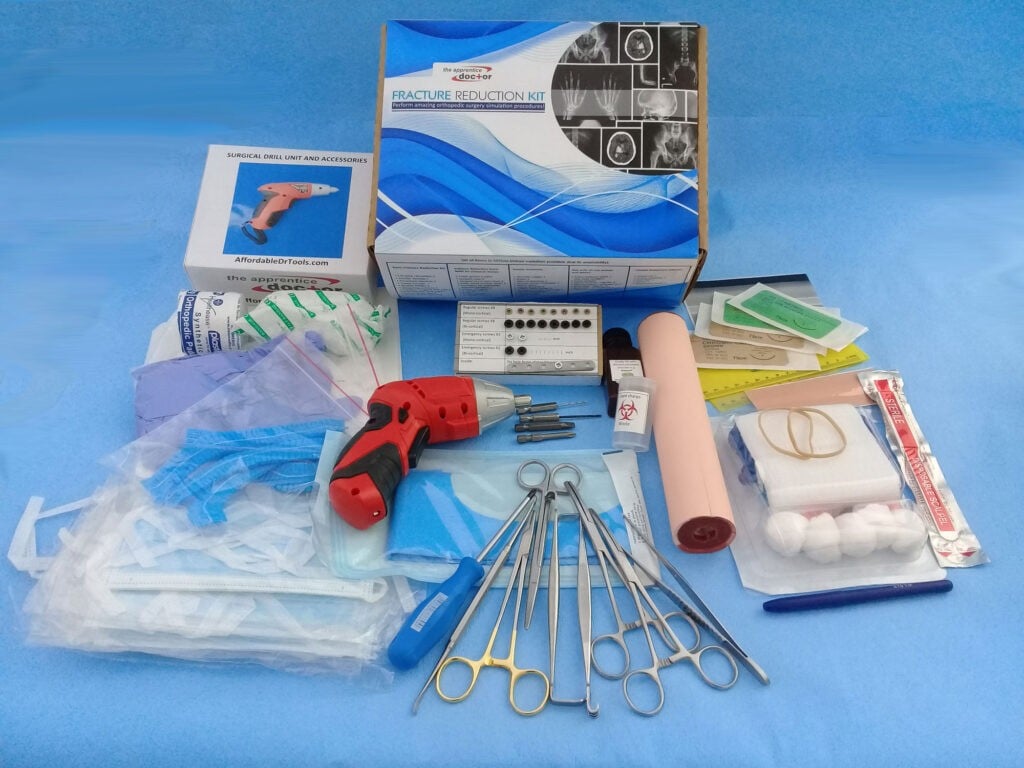Experience the Intensity of Real Orthopedic Surgery!
Perform amazingly realistic simulation surgery gaining practical experience with various open and closed fracture reduction methods. Get practical experience and insight into basic surgical principles. Suture the surgical wound in layers. Practice at home or wherever you are.

Lay a solid foundation for these surgical skills:
- Basic surgical principles
- Sterility and aseptic technique
- Good lighting
- Sharps safety
- Scalpel holds
- Incision
- Dissection and hemostasis
- Wound closure in layers
- Suturing and knot tying techniques
- Wound dressing
- Orthopedic principles
- Reduction, fixation and immobilization
- Casts, splints and slings
View this video of one of the multiple practical projects: “How to remove previously placed plates and screws.”
Ideal for both individuals as well as for group training: Students preparing for an Open Reduction and Internal Fixation Workshop
The Orthopedic Fracture Reduction Course’s Practical Projects:
Reduction of fractures through manipulation and immobilization
- Project CR1: The emergency management of a fracture
- Project CR2a: Closed reduction of a fracture using plaster of Paris (POP) cast
- Project CR2b: Closed reduction of a fracture using a fiberglass cast
Reduction of fractures of a long bone using ORIF
- Project OR1: Open reduction and internal fixation of a linear long bone fracture – Procedure 1
- Project OR2: Open reduction and internal fixation of a linear long bone fracture – Procedure 2
- Project OR3: Open reduction and internal fixation of a comminuted long bone fracture
- Project OR4: Open reduction and internal fixation of a segmental long bone fracture
- Project OR5: Remove plates and screws
Reduction of fractures using wire or implants
- Projects in development phase:
- Project OR6: Fixation of a longitudinal fracture using lag screws
- Project OR7: Fixation of a fracture using stainless steel wires
- Project OR8: Fixation of a fracture using intra-medullary rods
- Project OR9: Fixation of an animal cadaver fracture
- Project OR10: Fixation of fractures using Sawbones
- Project OR11: Fixation of a fracture using external fixators
- Project OR12: Repair a fracture using a bone graft
- Project OR13: Repair a fractured mandible
Research project ideas:
- Project RI1 A Comparative study of the post-operative bone strength of a fixated long bone fracture
- Project RI2 Design a research project using Sawbones
- Project RI3 Compare the wound strength using a variety of suturing techniques
Top 3 Reasons to Invest in the Fracture Reduction Simulation Kit
1
Because you can practice what you learn while you learn.
The medical profession is practical. You can read about how to ride a bike but you won’t be able to ride a bike until you start physically practicing. It’s the same with healthcare. Reading about how to deal with bone fractures has limited value if you don’t practice, make mistakes in a simulated setting, learn from that and correct yourself, and repeat until you’ve mastered the skills.
The medical profession is practical. You can read about how to ride a bike but you won’t be able to ride a bike until you start physically practicing. It’s the same with healthcare. Reading about how to deal with bone fractures has limited value if you don’t practice, make mistakes in a simulated setting, learn from that and correct yourself, and repeat until you’ve mastered the skills.
2
Because you will master today the instruments you’ll soon be using every day.
Getting acquainted with the tools of your future trade is not only incredible fun, it’s also highly beneficial and recommended.
Getting acquainted with the tools of your future trade is not only incredible fun, it’s also highly beneficial and recommended.
3
Because when it comes to reaching your dream and fulfilling your calling you have a one-track mind and you’re not playing games.
That is the mindset you will need to make it on the highly competitive road of pursuing a career in healthcare.
That is the mindset you will need to make it on the highly competitive road of pursuing a career in healthcare.
Order the Fracture Reduction Simulation Kit
1 Kit is Ideal For 2 – 4 Students Working Together
